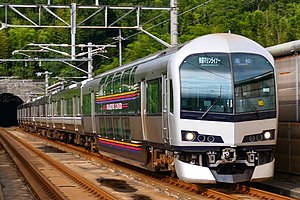This article has multiple issues. Please help improve it or discuss these issues on the talk page. (Learn how and when to remove these messages)
|
| 5000 series | |
|---|---|
 A 5000 series on a Marine Liner rapid service in September 2022 A 5000 series on a Marine Liner rapid service in September 2022 | |
| In service | October 2003–Present |
| Manufacturer | Kawasaki Heavy Industries (5000, 5200) Tokyu Car Corporation (5100) |
| Built at | Kobe, Yokohama |
| Replaced | 213 series |
| Constructed | 2003 |
| Number in service | 18 vehicles (6 sets) |
| Formation | 3 cars per trainset |
| Fleet numbers | M1–M6 |
| Operators | JR Shikoku |
| Depots | Takamatsu |
| Lines served | Seto-Ōhashi Line |
| Specifications | |
| Car body construction | Stainless steel |
| Car length | 20,100 mm (65 ft 11 in) 20,860 mm (68 ft 5 in) (5100) |
| Width | 2,950 mm (9 ft 8 in) |
| Height | 3,640 mm (11 ft 11 in) 4,070 mm (13 ft 4 in) (5100) |
| Maximum speed | 130 km/h (81 mph) |
| Traction system | Variable frequency (IGBT) |
| Acceleration | 2.5 km/(h⋅s) (1.6 mph/s) |
| Deceleration | 4.3 km/(h⋅s) (2.7 mph/s) (service) 5.2 km/(h⋅s) (3.2 mph/s) (emergency) |
| Electric system(s) | 1,500 V DC overhead catenary |
| Current collector(s) | S-PS60 scissors-type pantograph |
| Bogies | S-DT63 (Mc) S-TR63 (T) S-TR64 (Tswc) |
| Braking system(s) | Regenerative brake, electronically controlled pneumatic brakes |
| Safety system(s) | ATS-SS |
| Coupling system | Shibata-Type |
| Multiple working | 223 series |
| Track gauge | 1,067 mm (3 ft 6 in) |
| Notes/references | |
|
| |
The 5000 series (5000系) is a suburban electric multiple unit (EMU) train type operated by Shikoku Railway Company (JR Shikoku) in Shikoku, Japan.
Seven 2-car sets were introduced in 2003 by JR Shikoku along with the JR West 223-5000 series. 223–2000 series cars were later added to each set, and these were renumbered 5201 to 5207.
The 5100 type bilevel cab cars received the 47th Blue Ribbon Award in 2004.
Operations
JR Shikoku
JR West
- Seto-Ōhashi Line (Marine Liner)
- Honshi-Bisan Line (Kojima - Chayamachi)
- Uno Line (Chayamachi - Okayama)
Formation
Trainsets are formed as follows.
| Car No. | 1 | 2 | 3 |
|---|---|---|---|
| Designation | Tswc | T | Mc |
| Numbering | 5100 | 5200 | 5000 |
Car 3 is equipped with one S-PS60 scissors-type pantograph.
Interior
History
The 5000 series sets were all delivered during August 2003, and entered revenue service from the start of the revised timetable on 1 October 2003.
References
- ^ "S-DT63 S-TR63 S-TR64 / JR四国5000系". rail.hobidas.com (in Japanese). Neko Publishing. 26 February 2010. Archived from the original on 15 August 2021. Retrieved 13 May 2022.
- ^ JR電車編成表 2011夏 [JR EMU Formations - Summer 2011]. Japan: JRR. May 2010. p. 202. ISBN 978-4-330-21211-1.
External links
![]() Media related to JR Shikoku 5000 series at Wikimedia Commons
Media related to JR Shikoku 5000 series at Wikimedia Commons
| Current / active |
|  | ||||||||
|---|---|---|---|---|---|---|---|---|---|---|
| Retired / withdrawn |
| |||||||||


